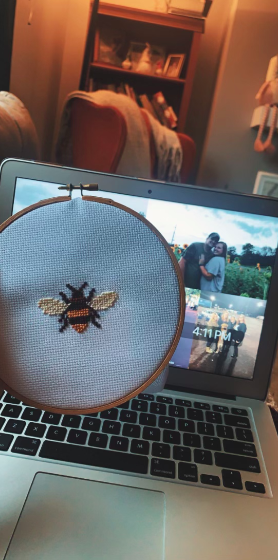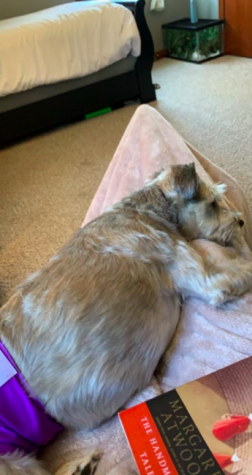Students contract coronavirus over winter break

Photo submitted by: Abby Lampe
Lampe took up cross-stitching in her free time during isolation.
February 4, 2021
Imagine being in a crowded grocery store three days before Christmas and receiving a phone call stating that you have tested positive for coronavirus.
This was the harsh reality for senior nursing major, Abby Lampe, who was initially given a false negative COVID-19 test.
“I just felt like I had to run and not risk exposing anyone,” Lampe said. “I ran out of that grocery store as fast as I could.”
After testing positive on Dec. 22, Lampe’s Christmas would not be the same as years past.
She spent most of her time in isolation watching shows, taking up cross-stitching and playing video games.
With relatively mild symptoms such as a cough, sore throat and altered sense of taste, Lampe remained calm and waited out her isolation period.
“It was not fun, but overall I didn’t have the worst symptoms I could have,” she said.
Lampe presumably contracted the virus from her mom who tested positive after returning from work. Her dad, however, never tested positive for COVID-19.
Despite showing symptoms of her own, Lampe was more concerned about the health of her parents who both have underlying health conditions.
“My dad has arthritis and my mom is a Type-2 diatbetic,” she said. When I found out I was positive, I really tried to isolate myself to just my room. I went down to get food and then went back up, just trying to keep my dad as safe as possible.”
Once her family became healthy again, Lampe learned something about the disorganization surrounding the pandemic protocols.
“In order to come back to school, I had to get my release-from-quarantine letter so I called my county health department and asked for it,” she said. “It took them just under a week to call me back and say that they had no idea that I tested positive.”
Lampe explained her situation to the county health department and they began asking questions about the people she was in contact with two weeks before symptoms surfaced.
“I was like, it’s been a month since my symptoms started so you’re asking if, six weeks ago, I hung out with anyone,” she said. “I thought it was insane, I don’t understand how they expect anyone to know that.”
Very quickly Lampe saw how COVID-19 can be passed onto others without any acknowledgement.
“It was really frustrating and eye-opening to watch how things are being handled even though it’s been a year almost since this started,” she said.
Throughout her time with COVID-19, Lampe also dealt with feelings of shame.
“I was really mad at myself,” she said. “I was so worried about getting it and I’ve done everything I should and yet here we are.”
This shame spiral also hit senior biology major, Kyla Brayshaw, but in a different way — knowing that she might have passed it onto a friend’s mom.
Although Brayshaw cannot pinpoint the exact spot where she contracted the virus, she believes it might have been at a small New Years Eve gathering.
“I felt really guilty if I had accidentally passed it onto anybody at work or to them at the party if that’s where my mom’s friend had gotten it,” she said.
Brayshaw believed the beginning of her symptoms to be a sinus infection, which is not uncommon for her during this time of year.
“It kind of just felt like when the air is dry in your house and you’re sleeping through that, just normal winter stuff,” she said.
After four days of mild symptoms, Brayshaw lost her sense of taste and decided to get tested.

“Shortly after that, I got hit with the fatigue pretty hard and then the shortness of breath which has just kind of been an ongoing lingering thing,” she said.
Admitting that this shortness of breath has left her feeling worried about her health, Brayshaw believes that COVID-19 may have impacted her long-term.
Nonetheless, Brayshaw knows that her situation could have been much worse.
“I just felt kind of grateful that I was in a healthy enough position beforehand to only have a mild case,” she said. “It kind of put it into perspective, how bad it could have been and how bad some people have it.”
While Lampe and Brayshaw have been told that they are immune to COVID-19 for a short time, neither of them feels a sense of relief.
“I still feel like I need to wear my mask and practice social distancing,” Brayshaw said. “I really don’t feel any different than before I had it.”
Due to being a nursing major, Lampe feels a responsibility to educate people about the seriousness of COVID-19.
“Just because you’re immune now doesn’t mean you can go out without a mask on,” she said. “I’m still trying to be overly cautious.”
Assistant professor for the College of Nursing, Jeri Berryman, describes the accuracy of immunity to be the best educated guess scientists have right now.
“I think three months is a minimum coverage and it may be longer, but we don’t know that yet,” she said. “To really say that without a doubt, we’ve got to keep studying it.”
Berryman is not surprised by the number of students who were diagnosed with Covid-19 over winter break, as a matter of fact, it was expected.
“When we go home on break and we’re students, we’re around more people because we want to see people that we haven’t seen,” she said. “It’s also still peak respiratory season and we’re indoors, windows aren’t open especially in colder climates.”
As students settle into campus life for another unusual semester, the concern of easily spreading COVID-19 arises.
“I think the statistics continue to support that with anyone who lives in crowded conditions, the likelihood of increasing the spread is there,” Berryman said. “College students are always lumped into that category.”
Overall though, Berryman believes that Ashland University has done a good job of mitigating the spread of COVID-19 on campus.
“I think we tried to get ahead of the game as best as we could with what we knew,” she said. “Our administration has done a good job trying to do what’s best to keep all of the students, faculty and staff healthy.”
The most important thing to remember, according to Berryman, is to be diligent about reporting symptoms and isolating when necessary.
Common symptoms of COVID-19 are fever, chills, cough, shortness of breath, fatigue, muscle or body aches, headache, new loss of taste or smell, sore throat, congestion, runny nose, nausea, vomiting or diarrhea, as stated by the Centers for Disease Control and Prevention.

If a student is diagnosed with COVID-19 and experiences mild to moderate symptoms, Berryman advises treating present symptoms with over-the-counter medication.
“Stay hydrated because hydration helps keep your secretions in and helps you feel better overall,” she said. “Rest is also very important, don’t over do it. When they say to isolate, do isolate and rest — rest your mind, rest your body.”
In addition, eating foods high in Vitamin C and Zinc can boost your immune system, potentially creating a quicker recovery time, Berryman said.
Brayshaw’s biggest takeaway from this experience is recognizing the importance of doing what everyone can to stop COVID-19.
“I’m not going to lie, I was careful, but probably similar to every other college student like ‘oh it’s probably not going to affect me or anything,’” she said. “Then you put it into perspective that we need to do what we can because it’s obviously affecting everybody.”
Over a month after recovering from COVID-19, Lampe struggles with a tightness in her lungs during some physical activity, like running.
“It’s not a joke I think is my biggest thing I try to stress to people,” she said. “My lungs still hurt.”
Lampe is motivated to be part of the COVID-19 education process and wants people, especially AU students, to see the risk in this virus.
“Just because there’s maybe 1% that is the death rate, it’s still not a joke,” she said. “That 1% is someone to someone, they may not be someone to you but it’s someone to someone.”

